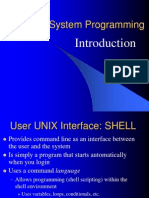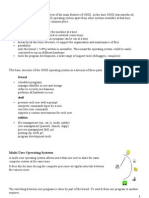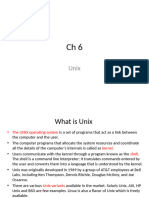UNIX History UNIX Kernel
Uploaded by
safiaquaUNIX History UNIX Kernel
Uploaded by
safiaquaUNIX History
UNIX Kernel
1965-1969 Bell Labs participates in the Multics project. 1969 Ken Thomson develops the rst UNIX version in assembly for an DEC PDP-7 1973 Dennis Ritchie helps to rewrite UNIX in C for PDP-11 1976 UNIX V6 common among American Universities. 1979 UNIX V7. First portable version of UNIX. 1979 UNIX V7 ported to VAX11 as UNIX/32V 1980-1985 Berkeley university develops 4.1BSD, 4.2BSD and 4.3BSD 1982-1985 Bell that now has become AT&T develops system III and system V 1985 Sun Microsystems uses 4.2BSD as a base for SunOS 1986 4.3BSD complete. 1992 NETBSD 0.8 1993 FreeBSD 1.0. Linus Torvalds puts out rst version of Linux on internet. 1994 4.4BSD 1995 4.4BSD Lite-2. The last UNIX distribution from Berkeley. 1996 OpenBSD 2.0
The kernel is the central part of the operating system and is always resident in the primary memory. The kernel performs among other things the following tasks:
Process handling memory handling I/O handling
User processes requests service from the kernel via system calls.
UNIX systems have many concurrent processes. New processes are created with the system call fork. Fork creates a new child process that is an exact copy of the parent process. Both the processes (parent and the child process) continues to execute at the instruction after fork. Fork returns the value 0 in the child process and a value bigger than 0 in parent process.
UNIX Processes
System Calls for Process Handling
Memory handling A UNIX process is divided in three logical segments:
Pid=fork() Create a child process. exit(status) Terminate the process that called exit. Pid=wait(status) Wait for a child process to terminate. execve(name,argv,envp) The code and data segments in the process that calls execve is replaced with data from the le "name". Open les, current directory and other status information is unchanged. The call on execve returns only if the call fails (otherwise there exists nothing to return to)
The code segment begins on virtual address 0. The code segment is (usually) write-protected and can be shared between different processes executing the same program. The data segment follows after the code segment and grows upward (against increasing addresses) The stack segment begins on the highest virtual address and grows downward (against decreasing addresses)
Input/Output
External Devices
All I/O in UNIX is carried out on byte streams. All structure in byte streams are dened by application programs. The system calls read and write works with unstructured byte streams. A byte stream can be linked to an arbitrary external unit. For example a disk memory, a terminal or a tape unit. Read and write works in the same way for all types of external units.
External devices can be reached via special les in the le system. Of convention all the special les are located in the directory /dev. In the operating system, an external device is identied by its device number. A device number can be divided in a major device number and a minor device number. The major device number identies which driver that deals with the device. The minor device number is used by the driver to distinguish between different logical units, handled by the same driver. Each special le corresponds to a unique device number and is actually only a link to a device driver. Special les are read and is written in the same way as normal les.
Descriptors
System calls for Input/Output
A descriptor is a small positive number, often in the interval 1-32. A descriptor identies an open le or other byte stream within a certain process. Descriptors are created with the system calls open, pipe or socket. Each PCB contains a table of open les. The system call open returns a descriptor that actually is an index in this table. This table also have a pointer to the les inode. The system calls read and write uses the descriptor to identify which le to read or write.
All I/O in UNIX is handled mainly by the following system calls: read, write, open, close, lseek and ioctl. Open returns a descriptor for a new or existing le.
The ags parameter species the access mode and the mode argument species permissions. Reading and writing are done by:
Each open le has an I/O pointer that tells from where in the le the next byte will be read. After open the I/O pointer, points to byte zero. After read or write the I/O pointer is positioned at the byte after the last byte read or written.
The I/O pointer can be repositioned with the system call lseek ("long seek"):
Filters
UNIX File System
Output from a process can be sent directly to another process. A process that reads an input data stream and produces an output data stream is called a lter. Example:
A program that shall be used as a lter have to read from standard input and write to standard output
The UNIX le system has a hierarchical tree structure with the top in root. Files are located with the aid of directories. Directories can contain both le and directory identiers. The user identies les with absolute or relative path names. Example on absolute names: /usr/terry/notes/apr22.txt Each user has a login directory. The user can create his own subdirectories within the login directory. The system has information about a users current directory. At login, the home directory is set as current directory but this can be changed with the command cd. The operating system uses inodes as the internal name for les. An i-number is an index in a table of inodes. An entry in the inode table contains complete information about a certain le. A directory only contains a translation from "path name" to i-number.
10
Pipes
System calls for Pipe
A pipe is an one way buffered channel between two processes. Reading and writing to a pipe is done with the standard read and write system calls. Read and write operations to a pipe is blocking. Read blocks when reading from an empty pipe and write blocks when writing to a full pipe. Pipes can only be used between processes that are related with each other. A pipe is created with the system call pipe, that returns one le descriptor for reading and one le descriptor for writing. After a pipe is created, the system call fork is used to create a new process to communicate with. Current UNIX systems also have other facilities for communication, such as sockets.
Creates a buffered channel (pipe) for communication with another process. Two le descriptors are returned. ledes[0] is for reading, ledes[1] is for writing. The process must use fork to create a child process. The two processes can then use the pipe for communication.
Duplicates a le descriptor.
11
12
Shell
Shell
The command interpreter in UNIX is called the shell. The shell is a normal user program that reads command lines entered by the user and interprets them as commands to be executed. Several different shells are in common use: sh (Bourne shell) exists on almost all UNIX systems. csh (C shell) developed at Berkeley. tcsh An extended version of csh. ksh (Korn shell) is used above all on UNIX systems V. bash (Bourne Again Shell) from GNU is the most common shell on Linux. There also exists several graphical user interfaces for UNIX. The most common is the X window system.
The simplest form of command comprises a command name with arguments. For example: ls - l If the command name begins with / the shell tries to execute the le with that name. If the command does not begin with / the shell looks for the command in a number directories. Which directories to search and in which order is determined by the environment variable PATH.
Programs executed by the shell has three open les: Standard input (le descriptor 0) reads from the terminal. Standard outputs (le descriptor 1) writes to the terminal. Standard error (le descriptor 2) writes to the terminal.
13
14
Shell
Commands
Simple commands. for example: ls -l Redirection of stdin and/or stdout. pgm <le1 >le2. Data is read from le1 and written to le2. Redirecting stdout and stderr to the same le. pgm >& le1 Background jobs. pgm& Give prompt for the next job without waiting for pgm to terminate. Background jobs can be moved to the foreground by the command fg in csh. Pipes. sort le1 | head -20 | tail -5 Built in commands cd (change directory). Some commands need to be executed internally by the shell (Normal commands are executed by a child process)
15
You might also like
- Unix Programming (Code:18CS56) : Presented byNo ratings yetUnix Programming (Code:18CS56) : Presented by132 pages
- Learning UNIX.: 2.0 Main Features of UNIXNo ratings yetLearning UNIX.: 2.0 Main Features of UNIX59 pages
- Essentials For Scienti - C Computing: Introduction To UNIX and Linux Day 1No ratings yetEssentials For Scienti - C Computing: Introduction To UNIX and Linux Day 16 pages
- UNIX Operating System: By, Patil Shubham Prabhakar Roll No: 7037 Fy MSC (CS)No ratings yetUNIX Operating System: By, Patil Shubham Prabhakar Roll No: 7037 Fy MSC (CS)21 pages
- Introduction To UNIX: Motivate The Use of UNIX Introduce Basic UNIX Features (E.g. Using Directories, Files) IntroduceNo ratings yetIntroduction To UNIX: Motivate The Use of UNIX Introduce Basic UNIX Features (E.g. Using Directories, Files) Introduce48 pages
- Section 1 Introduction To Unix: Structure Page NosNo ratings yetSection 1 Introduction To Unix: Structure Page Nos14 pages
- UNIX Concepts: 1. How Are Devices Represented in UNIX?No ratings yetUNIX Concepts: 1. How Are Devices Represented in UNIX?15 pages
- Systems Programming: 5. File I/O Using System CallsNo ratings yetSystems Programming: 5. File I/O Using System Calls24 pages
- UNIX Shell Scripting Interview Questions, Answers, and Explanations: UNIX Shell Certification ReviewFrom EverandUNIX Shell Scripting Interview Questions, Answers, and Explanations: UNIX Shell Certification Review4.5/5 (4)
- Essentials For Scienti - C Computing: Introduction To UNIX and Linux Day 1Essentials For Scienti - C Computing: Introduction To UNIX and Linux Day 1
- UNIX Operating System: By, Patil Shubham Prabhakar Roll No: 7037 Fy MSC (CS)UNIX Operating System: By, Patil Shubham Prabhakar Roll No: 7037 Fy MSC (CS)
- Introduction To UNIX: Motivate The Use of UNIX Introduce Basic UNIX Features (E.g. Using Directories, Files) IntroduceIntroduction To UNIX: Motivate The Use of UNIX Introduce Basic UNIX Features (E.g. Using Directories, Files) Introduce
- Section 1 Introduction To Unix: Structure Page NosSection 1 Introduction To Unix: Structure Page Nos
- UNIX Concepts: 1. How Are Devices Represented in UNIX?UNIX Concepts: 1. How Are Devices Represented in UNIX?
- Systems Programming: 5. File I/O Using System CallsSystems Programming: 5. File I/O Using System Calls
- The 101 Most Important UNIX and Linux CommandsFrom EverandThe 101 Most Important UNIX and Linux Commands
- UNIX Shell Scripting Interview Questions, Answers, and Explanations: UNIX Shell Certification ReviewFrom EverandUNIX Shell Scripting Interview Questions, Answers, and Explanations: UNIX Shell Certification Review



























































